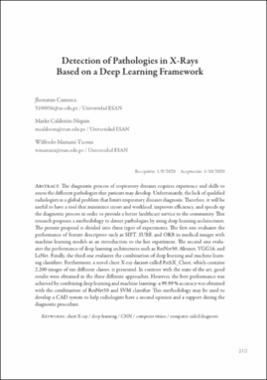Mostrar el registro sencillo del ítem
Detection of Pathologies in X-Rays Based on a Deep Learning Framework
| dc.contributor.author | Camasca, Jhonatan | |
| dc.contributor.author | Calderón Niquin, Marks | |
| dc.contributor.author | Mamani Ticona, Wilfredo | |
| dc.date.accessioned | 2021-08-20T16:38:52Z | |
| dc.date.available | 2021-08-20T16:38:52Z | |
| dc.date.issued | 2021 | |
| dc.identifier.citation | Camasca, J., Calderón-Niquin, M. & Mamani-Ticona, W. (2021). Detection of Pathologies in X-Rays Based on a Deep Learning Framework. En Universidad de Lima (Ed.), Construyendo un mundo inteligente para la sostenibilidad. Actas del III Congreso Internacional de Ingeniería de Sistemas (pp. 213-224), Lima, 17 y 20 de noviembre del 2020. Universidad de Lima, Fondo Editorial. | es_PE |
| dc.identifier.uri | https://hdl.handle.net/20.500.12724/13922 | |
| dc.description.abstract | The diagnostic process of respiratory diseases requires experience and skills to assess the different pathologies that patients may develop. Unfortunately, the lack of qualified radiologists is a global problem that limits respiratory diseases diagnosis. Therefore, it will be useful to have a tool that minimizes errors and workload, improves efficiency, and speeds up the diagnostic process in order to provide a better healthcare service to the community. This research proposes a methodology to detect pathologies by using deep learning architectures. The present proposal is divided into three types of experiments. The first one evaluates the performance of feature descriptors such as SIFT, SURF, and ORB in medical images with machine learning models as an introduction to the last experiment. The second one evaluates the performance of deep learning architectures such as ResNet50, Alexnet, VGG16, and LeNet. Finally, the third one evaluates the combination of deep learning and machine learning classifiers. Furthermore, a novel chest X-ray dataset called PathX_Chest, which contains 2,200 images of ten different classes, is presented. In contrast with the state of the art, good results were obtained in the three different approaches. However, the best performance was achieved by combining deep learning and machine learning: a 99.99 % accuracy was obtained with the combination of ResNet50 and SVM classifier. This methodology may be used to develop a CAD system to help radiologists have a second opinion and a support during the diagnostic procedure | es_PE |
| dc.format | application/pdf | es_PE |
| dc.language.iso | spa | es_PE |
| dc.publisher | Universidad de Lima | es_PE |
| dc.relation.ispartof | urn:isbn:978-9972-45-563-6 | |
| dc.rights | info:eu-repo/semantics/openAccess | es_PE |
| dc.rights | Atribución-NoComercial-CompartirIgual 2.5 Perú | * |
| dc.rights.uri | http://creativecommons.org/licenses/by-nc-sa/2.5/pe/ | * |
| dc.source | Repositorio Institucional - Ulima | es_PE |
| dc.source | Universidad de Lima | es_PE |
| dc.subject | Radiografía | es_PE |
| dc.subject | Diagnóstico asistido por ordenador | es_PE |
| dc.subject | Enfermedades respiratorias | es_PE |
| dc.subject | Aprendizaje automático | es_PE |
| dc.subject | Aprendizaje profundo | es_PE |
| dc.subject | Radiography | en_EN |
| dc.subject | Diagnosis, Computer Assisted | en_EN |
| dc.subject | Respiration Disorders | en_EN |
| dc.subject | Machine learning | en_EN |
| dc.subject | Deep learning | en_EN |
| dc.subject.classification | Ingeniería de sistemas / Software | es_PE |
| dc.title | Detection of Pathologies in X-Rays Based on a Deep Learning Framework | es_PE |
| dc.title.alternative | Detección de presencia patológica en radiografías basada en un marco de deep learning | es_PE |
| dc.type | info:eu-repo/semantics/conferenceObject | es_PE |
| dc.type.other | Artículo de conferencia | |
| dc.publisher.country | PE | es_PE |
| dc.subject.ocde | https://purl.org/pe-repo/ocde/ford#2.02.04 | es_PE |



